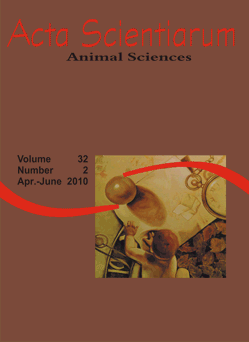<b>Mannanoligosaccharides in diets for Nile tilapia, juveniles</b> - doi: 10.4025/actascianimsci.v32i2.7724
Keywords:
Performance, intestinal morphology, fish, prebiotic
Abstract
This study was carried out to assess the inclusion of mannanoligosaccharides (MOS) in diets for Nile tilapia juveniles. Two-hundred and twenty fish with an average initial weight of approximately 25 ± 1.0 g were used, during 53 days. Fish were distributed in a randomized block design. Each 1,000 L tank with four cages (0.12 m3 each), was considered as a block; fish in each cage received a different dietary treatment. A control diet with 28.5% of crude protein and 2,855 kcal of digestible energy kg-1 was used and dietary MOS was included at 0, 1, 2 and 3%. No effects of MOS on feed intake, hepatosomatic index, survival, moisture, body ash, apparent digestibility coefficients of dry matter, gross energy, crude protein, ether extract and ash availability, intestinal villi density and number of goblet cells per villus were observed. The best values of feed-to-gain ratio, protein efficiency ratio, body composition and villi height were observed in fish fed with dietary MOS. It was concluded that 1% of dietary MOS is adequate for Nile tilapia juveniles.Downloads
Download data is not yet available.
Published
2010-04-08
How to Cite
Schwarz, K. K., Furuya, W. M., Natali, M. R. M., Michelato, M., & Gualdezi, M. C. (2010). <b>Mannanoligosaccharides in diets for Nile tilapia, juveniles</b> - doi: 10.4025/actascianimsci.v32i2.7724. Acta Scientiarum. Animal Sciences, 32(2), 197-203. https://doi.org/10.4025/actascianimsci.v32i2.7724
Issue
Section
Nonruminant Nutrition
DECLARATION OF ORIGINALITY AND COPYRIGHTS
- I Declare that current article is original and has not been submitted for publication, in part or in whole, to any other national or international journal.
The copyrights belong exclusively to the authors. Published content is licensed under Creative Commons Attribution 4.0 (CC BY 4.0) guidelines, which allows sharing (copy and distribution of the material in any medium or format) and adaptation (remix, transform, and build upon the material) for any purpose, even commercially, under the terms of attribution.
Read this link for further information on how to use CC BY 4.0 properly.
0.9
2019CiteScore
29th percentile
Powered by 








































